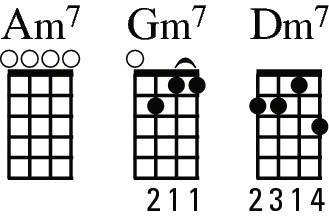Ukulele For Dummies (29 page)
Read Ukulele For Dummies Online
Authors: Alistair Wood

Some songs in
Ukulele For Dummies
which use the F chord family are âBanana Boat Song' (Figure 5-27), âMan of Constant Sorrow' (Figure 6-7) and âAmazing Grace' (Figure 9-2).
The D minor chord family uses exactly the same chords as the F family, as you can see in the song âIn the Pines' (Figure 9-3).
Playing according to the A chord family
You need two new chords for the A family (as illustrated in Figure 6-25):
 C
C m uses the Am moveable shape (familiar from Bm) moved up so that you're barring across the fourth fret. The four at the top right corner in the chord diagram indicates that, rather than starting at the nut, the diagram starts at the fourth fret.
m uses the Am moveable shape (familiar from Bm) moved up so that you're barring across the fourth fret. The four at the top right corner in the chord diagram indicates that, rather than starting at the nut, the diagram starts at the fourth fret.
 F
F m is just the A chord with the E-string played at the second fret with your ring finger.
m is just the A chord with the E-string played at the second fret with your ring finger.
The A family of chords works particularly well for blues songs and you can hear it used in âCareless Love' (Figure 12-5) and the 12-bar blues examples (see Figure 5-25).
Figure 6-25:
A chord family diagrams.

Discovering the D chord family
The D chord family isn't quite as easy as the rest of the families in this section, with it containing the moveable Bm chord and the D itself being quite tricky. But lots of songs use it, such as âLinstead Market' (see Figure 15-2).
The D chord family is shown in Figure 6-26.
The B minor family contains the same chords as the D family. That's the set of chords that you use in the reggae playing in Figure 15-5.
Figure 6-26:
D family chord diagrams.

Attempting More Complex Chords
Generally speaking, major, minor and seven chords â the three types of chords that I introduce in Chapter 4 and discuss throughout this book â each have their own distinct characteristics:
 Major chords are upbeat and confident.
Major chords are upbeat and confident.
 Minor chords are deep and sad.
Minor chords are deep and sad.
 Seven chords are jazzy and expectant.
Seven chords are jazzy and expectant.
This section, however, introduces a few new types of chord that add an even richer dimension to your sound.
Making melancholy minor 7 chords
Minor 7 chords have the sad sound of a minor chord but mixed with a jazzy tingle that makes the chord more melancholy. In the chord families you can use minor 7 chords as an alternative to the minor chords.
Figure 6-27 shows the three main minor 7 shapes. The first is Am7, which is dead easy â you play all the strings open. The Gm7 shape is just like a B chord with your ring finger removed. The Dm7 shape is a Dm chord with the addition of the little finger fretting the A-string at the third fret.
chord with your ring finger removed. The Dm7 shape is a Dm chord with the addition of the little finger fretting the A-string at the third fret.
For example, you can hear the Am7 and Dm7 chords being used in the jazz example in Figure 14-6.
Figure 6-27:
Am7, Gm7 and Dm7 chord diagrams.

Relaxing with major 7 chords
Major 7 (maj7 for short) chords sound less strident than straight major chords and have a more laid-back and jazzy sound. Figure 6-28 starts out with an Amaj7 setting up the mellow tone.
Figure 6-28:
Amaj7, Gmaj7 and Cmaj7 chord diagrams.